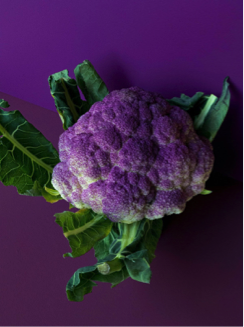Cauliflower
-
Scientific NameBrassica oleacea
-
General InformationCauliflower is a cool season crop that requires attention to timing and care. Cauliflower has an edible flower head, leaves, and upper part of the stem. There are two varieties: short-season (40-70 days) and long-season (90-200 days).
 Photo: Unsplash
Photo: Unsplash -
When to Plant
Depending upon microclimate, short-season seeds can be started indoors between January and April and transplanted outdoors February through April. Short-season seeds can also be started indoors in July or August and transplanted in August or September for a fall harvest. In warmer microclimates, avoid growing cauliflower in the garden in the hot summer months. Best grown when air temperatures are between 60 to 65 degrees.
Long-season seeds can be sown outdoors June through August for a harvest in the late winter or early spring. Long season varieties may take up to 6 months to form a head, and may take another one to two months when overwintering.
-
Planting
Select disease resistant varieties. Avoid planting where plants of the Brassica family have been grown within the past three years.
Sow seeds half-inch deep; sow seeds indoors in seed flats. Plant seedlings outdoors 18 to 24 inches apart. Select seedlings with at least four to six leaves and bury them to the first leaf. If grown in the late summer for a fall harvest, protect seedlings from sunburn with shade cloth or floating row cover in the middle of the day for at least a week after planting.
-
Soil Requirements
Soil should drain well. Seedlings do best in a rich soil high in organic matter. Plants in clay soils or soils lacking nutrients may produce stunted heads.
-
Water Requirements
Keep soil moist during the seed germination period. Water deeply on a regular basis (two to three times per week depending on weather and keep soil moist in the winter if there is a lack of rainfall). Avoid overhead watering, uneven watering, and over-wetting the soil. Water less if leaves begin to turn yellowish.
-
Fertilizing
Consider light applications of nitrogen fertilizer every three to four weeks. For long-season varieties, fertilize as growth picks up in late winter. An organic mulch will add nutrients and help suppress weeds.
-
Pollination
Requires pollinators for fertilization.
-
Harvesting
Short-season varieties seeded in January and transplanted planted in February or March can be harvested between April and June.
Short-season varieties transplanted in August can be harvested in late September or October.
Long-season varieties can be harvested six to eight months after planting.
-
Storage
Store in refrigerator vegetable bin on high humidity if possible.
Do not store with apples, melons and tomatoes to avoid yellowing.
-
Good Varieties for Marin
Excellent short-season variety: ‘Snow Crown’ (50 to 60 days to maturity)
Also recommended: ‘Snow King’ ‘Snowball Y’ ‘Snowball A’
Purple varieties: ‘Purple Cape’ ‘Rosalind’ ‘Graffiti F1’ (the first two turn greenish when cooked)
Yellow-green varieties: ‘Green Harmony’ (short season) ‘Emerald F1’ (long season, 125 days to maturity)
Orange variety: ‘Cheddar F1’
-
Helpful Tips
Do not leave seedlings in pots too long before transplanting to avoid stunted plants and small heads.
Some varieties may turn pinkish or yellowish by the sun; shade heads with leaves or floating row covers.
Do not leave heads on plants too long even if they are smaller than those found at the store.
Don’t plant too many that mature all at once as they don’t hold very long in the garden.
-
Common Problems
Cauliflower is prone to “buttoning” or stunting if grown in soil lacking nutrients or held too long in the container before transplanting.
-
Pests- Diseases & More
Caterpillars and cabbage worms can be removed by hand or treated with Bacillus thuringiensis (Bt) if paper collars around the base of plants and row covers are not effective.
To control aphids, blast them off with a hose or apply insecticidal soaps. If aphids are on harvested plants, soak in warm water with a little white vinegar until they release and float to the top
Chewers like harlequin bugs, slugs, and snails can be handpicked and squished.
To encourage insects that are beneficial, plant aromatic herbs nearby.

